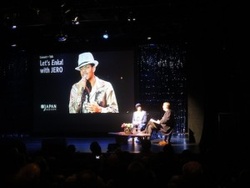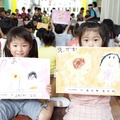A diverse crowed filled Japan Society’s auditorium Saturday night. They were young, middle-aged, and not so young. They were Japanese, half Japanese, part Japanese, and non-Japanese. They were wearing jeans, dresses, and kimono. And they were all there for the New York debut of Jero, a Pittsburgh native who has achieved success in Japan in the unlikeliest of professions: He’s an enka singer.
Enka, a Japanese ballad that became popular during the postwar era, generally has a fan base that is considerably older than Jero, who, at age thirty, prefers the hip-hop style of clothing to suits or kimono. But his fans don’t care about what he’s wearing; they simply love what he’s singing.
Before his performance, Jero sat down onstage for a tête-à-tête with John Wheeler, former Executive Vice President of Japan Society and an authority on US-Japan relations. Wheeler asked Jero, whom he called “a true cross-cultural trailblazer,” to describe his improbable road from Pittsburgh to Japan’s enka community.
Born Jerome Charles White Jr., Jero’s path to enka stardom began with his maternal grandmother, a Japanese woman who married an African American—highly uncommon in Japan at that time—and filled their home with the melancholy strains of her favorite ballads. As a young boy, Jero sang these songs to his grandmother.
“I loved her to death; she spoiled me rotten,” Jero says.
Noticing how happy his singing made her, Jero told his grandmother he would become an enka singer, promising her he would one day appear on Kohaku Uta Gassen, Japan’s revered New Year’s Eve contest between male and female music stars.
He moved to Japan in 2003 after graduating from the University of Pittsburgh, teaching English and working as a computer engineer.
“I had no idea how to become an enka singer at all,” Jero says. “What I remember hearing from Japanese TV or my grandmother was that a lot of enka singers got scouted from a karaoke contest or singing contests. So that’s where I started searching for things.”
His search allowed him to keep his promise to his grandmother. Victor Entertainment discovered him, and after receiving vocal training and releasing an album, Jero was invited to sing on Kohaku Uta Gassen in 2008. Unfortunately, Jero’s beloved grandmother died in 2005 without knowing his success in the world of enka.
The artists whose songs he grew up singing welcomed him into the enka community. They embraced his respect for the genre, his talent, and even his chosen style of dress, which reflects the hip-hop side of his identity.
“I told my management that I wanted to be me when I got onstage, so I kind of wanted to keep the way that I dress every day, which would be baggy jeans—ON THE WAIST, not down below,” Jero says. “When I first came out, I kind of wanted to be different—I did want to be different. And I wanted to get younger audiences listening to the music. And I think it helped them identify with somebody…dressing the way they do and saying, ‘It’s okay to listen to this music. I’m just as young as you, so don’t be embarrassed to listen to enka.’”
Clad in a bright blue suit, Jero delighted young and old at Japan Society with his debut hit, “Umiyuki” (“Ocean Snow”), and popular enka standards by stars such as Misora Hibari and Itsuki Hiroshi, with whom most of the audience seemed familiar.
However, for some people enka was a brand new experience. Knowing that people in the audience might not understand all of the lyrics to the songs, Jero explains, “Eighty percent of enka songs are very sad. Very, very sad. Twenty percent are not sad.”
One of Jero’s songs that isn’t sad is “Hare Butai,” (“The Biggest Moment”), which Jero asked pop singer/songwriter Ataru Nakamura to write for his mother. Jero also introduced “Yoake no Kaze” (“Dawn Wind”), a song from his latest album. For Jero’s encore, he and the entire audience sang “Ue o Muite Aruko,” the 1961 hit that Westerners know as “Sukiyaki.”
Jero presented himself as a professional, talented entertainer with a smooth, beautiful voice and a charming personality to go along with it. He showed his sense of humor in between songs as he bantered back and forth with a woman in the audience. She can’t be described as a heckler because she clearly loved him—and told him so on more than one occasion—and she presented him with flowers, which he graciously accepted during a song. Near the end of the concert he implored the audience to follow him on Twitter (@jeroenka), lamenting that he had only five thousand followers. “Other famous people have 100 thousand followers,” he says.
The singer also proved he is a patient man, waiting more than an hour after the show, autographing CDs, shaking hands, and posing for pictures with fans in the Japan Society lobby. He swapped his blue suit for a T-shirt and the Pirates cap for one bearing the interlocking NY, but the dazzling smile remained.
* This article was originally published in JapanCulture•NYC.com on June 13, 20102.
© 2012 Susan Hamaker








